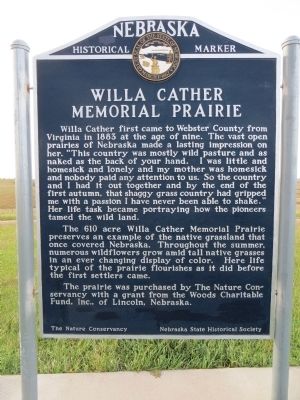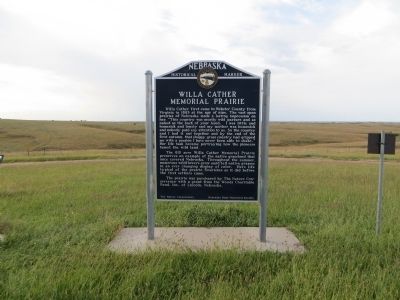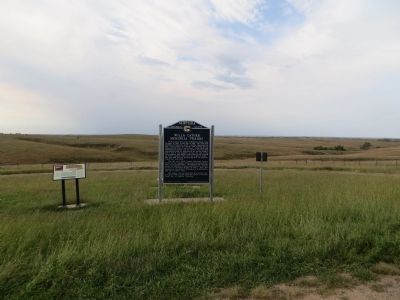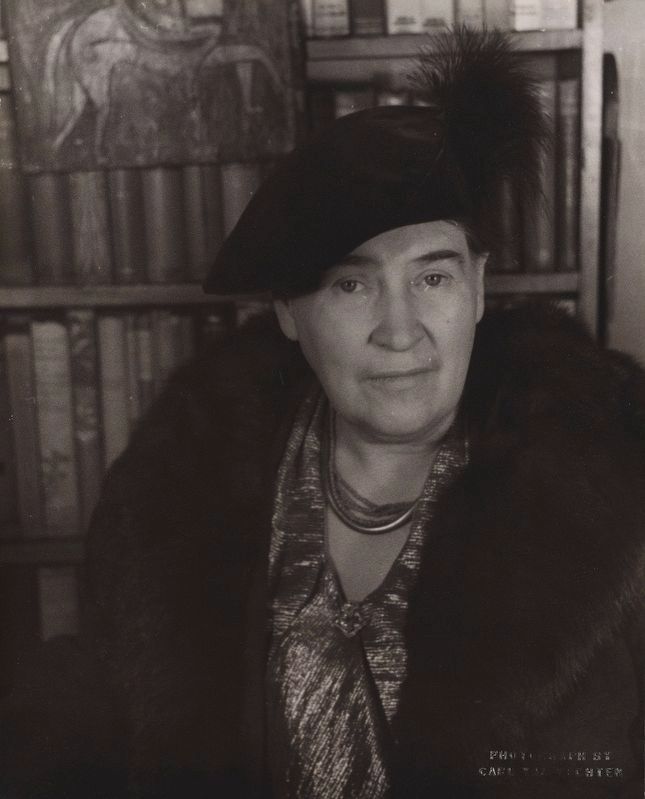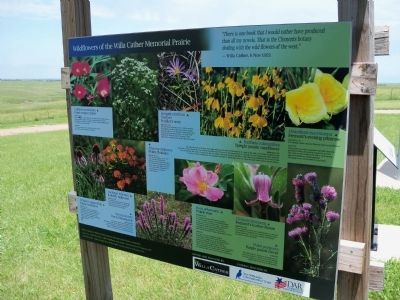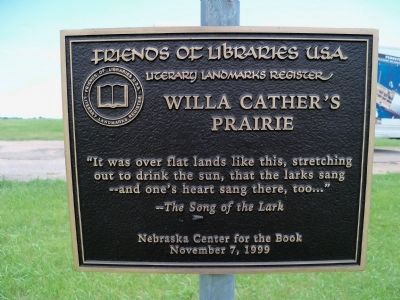Near Red Cloud in Webster County, Nebraska — The American Midwest (Upper Plains)
Willa Cather Memorial Prairie
Willa Cather first came to Webster County from Virginia in 1883 at the age of nine. The vast open prairies of Nebraska made a lasting impression on her. "This country was mostly wild pasture and as naked as the back of your hand. I was little and homesick and lonely and my mother was homesick and nobody paid any attention to us. So the country and I had it out together and by the end of the first autumn, that shaggy grass country had gripped me with a passion I have never been able to shake." Her life task became portraying how the pioneers tamed the wild land.
The 610 acre Willa Cather Memorial Prairie preserves an example of the native grassland that once covered Nebraska. Throughout the summer, numerous wildflowers grow amid tall native grasses in an ever changing display of color. Here life typical of the prairie flourishes as it did before the first settlers came.
The prairie was purchased by the Nature Conservancy with a grant from the Woods Charitable Fund of Lincoln, Nebraska.
Erected by The Nature Conservancy and Nebraska State Historical Society. (Marker Number 176.)
Topics and series. This historical marker is listed in these topic lists: Arts, Letters, Music • Environment • Parks & Recreational Areas • Women. In addition, it is included in the Nebraska State Historical Society series list. A significant historical year for this entry is 1883.
Location. 40° 0.23′ N, 98° 31.368′ W. Marker is near Red Cloud, Nebraska, in Webster County. Marker can be reached from U.S. 281. Marker is just north of the Kansas/ Nebraska state line, in a road side pull-out on the west side of the highway. Touch for map. Marker is in this post office area: Red Cloud NE 68970, United States of America. Touch for directions.
Other nearby markers. At least 8 other markers are within 13 miles of this marker, measured as the crow flies. Burlington Depot (approx. 5.1 miles away); Red Cloud Volunteer Fire Department Bell (approx. 5.8 miles away); Cather Childhood Home (approx. 5.8 miles away); Red Cloud (approx. 5.8 miles away); Cottonwood Tree - 1871 (approx. 5.9 miles away); Grace Episcopal Church (approx. 6 miles away); 1871 Webster County 1971 (approx. 6 miles away); U.S. Geographic Center Cedar Tree (approx. 12½ miles away in Kansas). Touch for a list and map of all markers in Red Cloud.
Related markers. Click here for a list of markers that are related to this marker. These are some of Willa Cather’s residences that were marked with historical markers, beginning with her birthplace in Virginia.
Also see . . . Wikipedia entry for Willa Cather. Excerpt:
By this time, Cather was firmly established as a major American writer, receiving the Pulitzer Prize in 1923 for her World War I-based novel, One of Ours. She followed this up with the popular Death Comes for the Archbishop in 1927, selling 86,500 copies in just two years, and which has been included on the Modern Library 100 Best Novels of the twentieth century. Two of her three other novels of the decade—A Lost Lady and The Professor's House—elevated her literary status dramatically. She was invited to give several hundred lectures to the public, earned significant royalties, and sold the movie rights to A Lost Lady.(Submitted on December 3, 2022, by J. J. Prats of Powell, Ohio.)
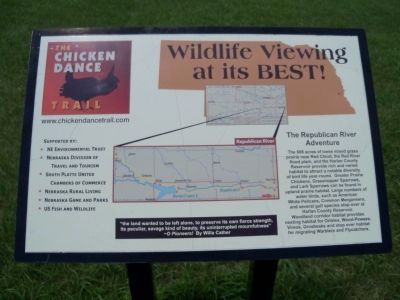
Photographed By James King, June 20, 2015
6. The Chicken Dance Trail
Wildlife Viewing at its BEST!
Wildlife Viewing at its BEST!
The Republican River Adventure
The 608 acres of loess mixed grass prairie near Red Cloud, the Red River flood plain, and the Harlan County Reservoir provide rich and varied habitat to attract a notable diversity of bird live year-round. Greater Prairie Chickens, Grasshopper Sparrows, and Lark Sparrows can be found in upland prairie habitat. Large numbers of water birds, such as American White Pelicans, Common Mergansers, and several gull species stop over at Harlan County Reservoir. Woodland corridor habitat provides nesting habitat for Orioles, Wood-Pewees, Vireos, Grosbeaks and stop over habitat for migrating Warblers and Flycatchers.
The 608 acres of loess mixed grass prairie near Red Cloud, the Red River flood plain, and the Harlan County Reservoir provide rich and varied habitat to attract a notable diversity of bird live year-round. Greater Prairie Chickens, Grasshopper Sparrows, and Lark Sparrows can be found in upland prairie habitat. Large numbers of water birds, such as American White Pelicans, Common Mergansers, and several gull species stop over at Harlan County Reservoir. Woodland corridor habitat provides nesting habitat for Orioles, Wood-Pewees, Vireos, Grosbeaks and stop over habitat for migrating Warblers and Flycatchers.
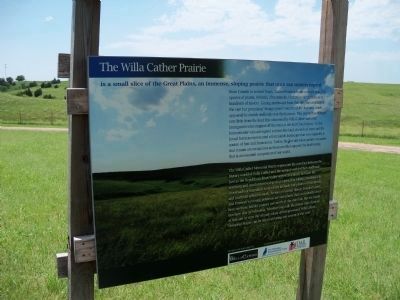
Photographed By James King, June 20, 2015
7. Willa Cather Prairie
is a small slice of the Great Plains, an immense, sloping prairie that once ran uninterrupted from Canada to central Texas. Cather Prairie is home to more than 250 species of plants, 59 birds, 29 mammals, 13 reptiles/amphibians and hundreds of insects. Gazing northward from this site, one can imagine the vast but promising "shaggy grass" country of My Ántonia which appeared to stretch endlessly over the horizon. This prairie has changed very little from the land first witnessed by Willa Cather and other immigrants who stepped off the train at the Red Cloud depot. To the homesteader who attempted to farm this land, the lack of trees and the broad horizon represented a formidable landscape that was originally a source of fear and frustration. Today, the few unbroken prairie remnants that remain are recognized as treasures that support the biodiversity that is an essential component of our world.
The Willa Cather Memorial Prairie represents the interface between the literary world of Willa Cather and the natural world of her childhood. Just as the Republican River Valley serves as a divide between the northern and southern mixed-grass prairies, this rolling grassland is a crossroads or transition zone where animals and plants with southern and northern affinities meet. Fremont's leather flower, Fendler's aster, and Fremont's evening primrose are rare plants that occasionally occur here on these border prairies just north of the state line, but are found nowhere else in Nebraska. Whether you walk the prairie trail or pause at this site to view the vibrant colors of this grassland, Willa Cather Memorial Prairie can be enjoyed during any season of the year.
The Willa Cather Memorial Prairie represents the interface between the literary world of Willa Cather and the natural world of her childhood. Just as the Republican River Valley serves as a divide between the northern and southern mixed-grass prairies, this rolling grassland is a crossroads or transition zone where animals and plants with southern and northern affinities meet. Fremont's leather flower, Fendler's aster, and Fremont's evening primrose are rare plants that occasionally occur here on these border prairies just north of the state line, but are found nowhere else in Nebraska. Whether you walk the prairie trail or pause at this site to view the vibrant colors of this grassland, Willa Cather Memorial Prairie can be enjoyed during any season of the year.
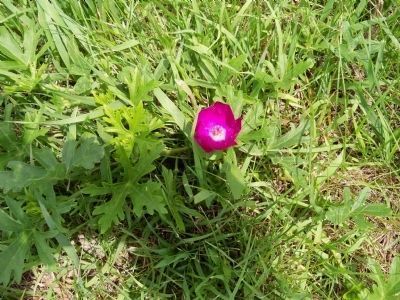
Photographed By James King, June 20, 2015
9. Purple Poppy Mallow
(Callirhoe involucrate)
(Callirhoe involucrate)
Medicinal Use:
Native Americans often boiled its roots and drank the liquid to ease internal pains or used it externally to bath aching body parts. The Lakotas and Dakotas inhaled the fumes from a smoldering root as a treatment for head colds.
Food Use:
The sweet starchy root is about the size of a carrot and tastes somewhat like a sweet potato
Native Americans often boiled its roots and drank the liquid to ease internal pains or used it externally to bath aching body parts. The Lakotas and Dakotas inhaled the fumes from a smoldering root as a treatment for head colds.
Food Use:
The sweet starchy root is about the size of a carrot and tastes somewhat like a sweet potato
Credits. This page was last revised on December 5, 2022. It was originally submitted on October 14, 2014, by Bill Kirchner of Tucson, Arizona. This page has been viewed 773 times since then and 33 times this year. It was the Marker of the Week December 4, 2022. Photos: 1, 2, 3. submitted on October 14, 2014, by Bill Kirchner of Tucson, Arizona. 4. submitted on December 3, 2022, by J. J. Prats of Powell, Ohio. 5, 6, 7, 8, 9, 10. submitted on July 19, 2015, by James King of San Miguel, California. • Andrew Ruppenstein was the editor who published this page.
